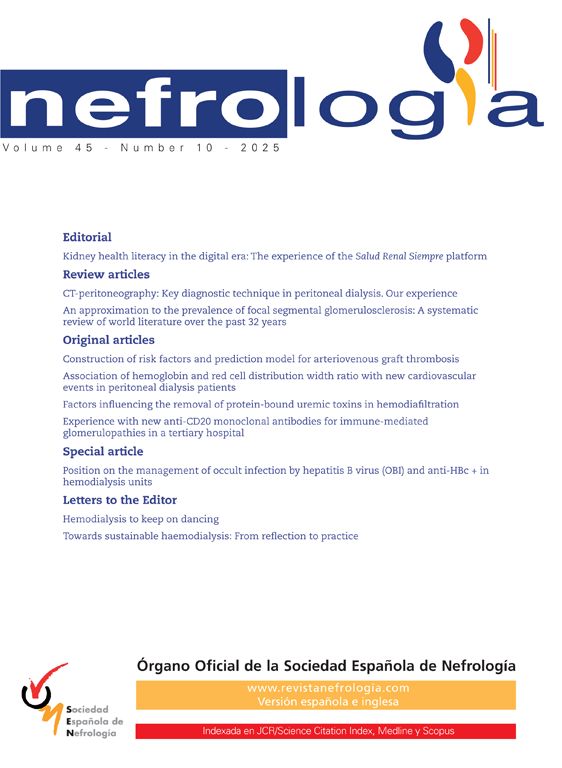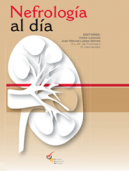INTRODUCTION
Bone mineral disease associated to chronic kidney disease (BMD-CKD) is an integral component of stage 5 D chronic kidney disease (CKD) in any of the dialysis techniques that conditions the clinical course, complications, and survival of patients.1 Changes in bone mineral metabolism promote vascular calcification and cardiovascular (CV) risk by mechanisms that are starting to be elucidated. Since publication in 2003 of the K/DOQI guidelines2 including recommendations for diagnostic management and treatment objectives, several studies have shown how far we are from reaching such standards. 3 The advent of new treatment strategies based on use of Cinacalcet® has improved results in some fields.4 However, virtually all studies available have been conducted in patients on hemodialysis.5 Only one of the randomized clinical trials enrolled 34 patients on peritoneal dialysis (PD) with an efficacy follow-up period of only 10 weeks, who were jointly analyzed with a large series of patients on HD.6
The purpose of this study was to assess the efficacy of Cinacalcet ® in patients with moderate to severe hyperparathyroidism (HPTH) resistant to conventional treatment on PD.
METHODS
This was a prospective, observational, cohort study using pretreatment values as reference. The primary objective was to assess compliance with K/DOQI recommendations, and secondary objectives included evaluation of compliance with suboptimal metabolic standards, tolerability and occurrence of side effects, and an estimation of the time required to reach those results.
Selected patients had to meet the following criteria: moderate to severe HPTH (PTH > 500 pg/mL with normal or elevated serum calcium levels) resistant to conventional treatment with diet, binders, and vitamin D, or impossibility to use vitamin D due to hyperphosphoremia (> 5.5 mg/dL) or hypercalcemia (> 10.5 mg/dL). All patients should have been monitored for at least 6 months on specific treatment by a nephrologist and should have been on PD with adequate efficacy for at least 4 months. No patient had hypocalcemia (calcium levels < 8.5 mg/dL).
Treatment was started with Cinacalcet-Mimpara® (AMGEN) 30 mg, and the dose was titrated monthly based on
the targets reached. Oral 1,25 OH vitamin D¿Rocaltrol® (ROCHE) was used according to the criteria recommended in clinical guidelines.2 Calcium-based binders were prescribed without exceeding 1,500 mg/day of elemental calcium, as well as non-metallic binders (Sevelamer-Renagel® GENZYME). For cost studies, the selling price excluding VAT of each product according to the 2007 price list was imputed. The initial calcium concentration in peritoneal fluid bags was 1.75 mEq/L. Use of calcium concentrations of 1.25 mEq/L was allowed depending on response and clinical course.
Clinical and laboratory data were collected from 4 months before treatment start to the end of follow-up. Two initial
two-weekly controls were performed, followed by monthly controls. Such controls included levels of at least calcium, phosphorus, alkaline phosphatase, albumin, and PTH. The same laboratory test methods were used throughout followup. Phosphorus and calcium were measured by UV spectrometry (normal ranges, 2.7-4.5 mg/dL and 8.6-10.4 mg/dL respectively), and PTH by immunoluminescence (normal range, 10-65 pg/mL). Calcium was corrected for serum albumin levels. Adjustments for PD efficacy and all other metabolic parameters were evaluated every two months and peritoneal equilibrium tests every 6 months, according to the standard protocol. A dietary survey, dietary counseling, and a specific survey for common side effects were done at each visit. Only patients more than 9 months on treatment were included in the analysis shown in the tables.
The targets used were those recommended by the NKFK/DOQI clinical guidelines for CKD 5D:2 PTH levels ranging
from 150 and 300 pg/mL; corrected serum calcium levels ranging from 8.4 and 9.5 mg/dL, phosphorus levels ranging from 3.5-5.6 mg/dL, and CaxP < 55 mg2/dL2. For the analysis of suboptimal targets, the previously published references of PTH < 350 pg/mL,4 phosphorus < 6 mg/dL, or calcium £ 10.4 mg/dL (the normal value at our laboratory) were used, provided the CaxP product was simultaneously < 55 mg2/dL2. The proportion of patients within the ranges of each optimal or suboptimal target are indicated at each time. The proportion of
patients meeting all optimal and suboptimal targets at each time point of follow-up is also indicated.
Data are given as mean and standard deviation (SD) or as percentage of patients depending on the nature of the variables. Medications are given as daily mg of Cinacalcet-Mimpara ® (AMGEN) and elemental calcium, number of Sevelamer ® 800 mg tablets (Renagel®; Genzyme) per day, and micrograms of 1,25 OH Vit D (Rocaltrol®; Roche) per week. Data were entered into a SPSS 11.0 database for statistical analysis. The laboratory values in each period were compared to baseline values using a non-parametric Wilcoxon test. A value of p < 0.05 was considered statistically significant. The date of the first value on target was considered as the event date in a Kaplan-Meier analysis. The median time to achievement of optimal or suboptimal control of all targets was calculated.
RESULTS
Cohort description: Eighteen patients (80.0% males) with a mean age at study start of 57.70 years (SD 9.22) were enrolled. The most relevant etiologies included diabetes mellitus (8.3%), polycystic renal disease (25.0%), glomerular (25.0%), interstitial (8.3%). At the start of treatment with Cinacalcet ®, patients had been on PD for a mean time of 15.56 months (SD 0.78). Patients received adequate APD (8/18) or CAPD (10/18) to reach appropriate efficacy levels (Kt/V 2.29 [SD 0.65], CCr 72.4) that were maintained during follow-up.
PD bags with two calcium concentrations (1.25 and 1.75 mEq/L) were available. The 1.75 mEq/L calcium concentration was used at treatment start in 84.6% of cases, at 3 months in 83.3%, at 6 months in 66.7%, at 9 months in 66.7%, and at one year in 75%, with a mean calcium value during the whole follow-up of 1.66 mEq/L (SD 0.19). Mean follow-up time on Cinacalcet® treatment was 11.9 months (range, 3-24.83 months). Two patients discontinued the study for transplant and one patient died from stroke.
Table I details the changes over time in laboratory values related to BMD-CKD in patients with longer than 9 months of treatment and the medication prescribed at the different follow-up time points.
No patient met the targets in the guidelines during the four months planned at the start of treatment with Cinacalcet®, as they all had PTH levels 3 500 pg/mL. Changes over time in the proportion of patients meeting each of the K/DOQI targets and the suboptimal targets described are shown in Table II. At the start, no patient met the aggregate of all K/DOQI targets or the proposed suboptimal targets. The mean starting dose of Cinacalcet® was 30 mg in all cases, and the subsequent mean doses were 36.4 mg at 1 month, 44 mg at 3 months, 43.5 mg at 6 months, and 28.5 mg at one year. Compliance with medication was verified in all patients, and frequent non compliance was only found in one patient (in whom optimal control of biochemical values was not achieved). Mean monthly costs of the whole medication for treatment of HPTH is detailed in Table I. Mean monthly cost of
Cinacalcet® was 270 e per patient at month 3 and 175 e per patient at month 12.
The mean time required to reach a PTH value on the K/DOQI range was 2.33 months (95% CI 1.35-3.32), while
the time to reach all suboptimal targets was 4.03 months (95% CI 2.25-5.82), and the time required to reach all optimal targets was 16.94 months (95% CI 11.38-22.5). Curves are detailed in figure 1.
Dyspepsia was recorded in two patients, self-limited diarrhea in one, gynecomastia in one, and 3 patients experienced pruritus from the start, but this disappeared in all cases when calcium and phosphorus levels were controlled. Dose reduction was only required in one patient due to side effects (painful gynecomastia), and discontinuation of Cinacalcet® administration was not required in any patient. Only 3 cases of mild hypocalcemia ranging from 7.5 and 8 mg/dL, all of them asymptomatic, were recorded.
DISCUSSION
This is the first specific study of systematic treatment with Cinacalcet in patients on PD. Overall, Cinacalcet was safe
and effective, and allowed for controlling biochemical markers in a majority of patients resistant to conventional treatment.
The approach to HPTH has evolved in recent years, with attention being now focused on the vascular field, beyond its effects on bone.7 The K/DOQI initiative attempted to unify the strategies of the different scientific societies around the world.8 Along these same lines, a change in nomenclature reinforcing this concept has been proposed.9 Indeed, there is evidence from observational studies of the relationship between the control level of BMD-CKD and the general course of patients. Data showing the relationship between hyperphosphoremia in HPTH and mortality and that failure to meet the objectives proposed by K/DOQI is associated to a poorer prognosis are available.1 A recent study has even shown that phosphorus reduction improves vital prognosis.10
Some recent European studies found the same prevalence of HPTH in incident patients on HD and PD, with very similar calcium and phosphorus levels and target achievement data for both procedures.1 However, a majority of the epidemiological data discussed, as well as Cinacalcet® studies, come from HD patients.5,11,12 In fact, we have found no specific study about treatment with Cinacalcet® in PD. Only a clinical trial enrolled 34 patients on PD together with a much greater number of patients on HD. Use of PD in Spain is increasing, but only reaches 15% of patients and is distributed in small units. The mean maintenance time on the procedure is less than 4 years.13 All these factors, combined with a decreased patient accessibility because it is a home procedure, reduce the interest of sponsors in enrolling these patients in clinical trials and hinder the initiatives directly promoted by nephrologists.
Patients on PD have some relevant differences in management of Cinacalcet®. First, very few cases of hypocalcemia have been found, and none of them was severe and/or symptomatic. The continuous presence of intra-abdominal fluid with adequate calcium levels may equilibrate this imbalance and protect patients from problems. On the other hand, Cinacalcet® doses higher than 60 mg/day were received by 3 patients only, and dose titration was more gradual than in the schemes recommended in clinical trials published,12 in which the dose was increased every month if objectives had not been reached. A slower titration taking into account the trend in laboratory tests may allow for a safer control, even if takes a longer time.
This is the first study to estimate the time required to reach adequate control values. Fifty percent of patients resistant to conventional treatment reached the PTH target in only 70 days. However, medication could only be temporally suspended in some patients, and long-term maintenance doses are required. There is only one report about the course with Cinacalcet ® beyond the first year of treatment.14
Another significant subject is the trend to the adynamic forms of BMD. Some series report a greater prevalence of adynamia in PD as compared to HD. Adynamia should be avoided because of its harmful effects.15 In fact, the factors associated to an increased risk of adynamic forms include the presence of diabetes, use of aluminium-based binders, overtreatment with high calcium levels and vitamin D, and PD itself.16
Guidelines themselves recommend that elevation of PTH levels is allowed by reducing aggressiveness of treatment
when PTH levels are below 100 pg/mL.2
We used the concept of suboptimal target compliance, encompassing a wider tolerance margin of PTH (350 pg/mL),
previously used by other authors,4 calcium levels within the normal ranges at our laboratory, and phosphorus levels increased by 0.5 mg/dL. In addition, the CaxP product should not be higher than 55 mg2/dl2. We think that outside a clinical trial with strict titration protocols, the clinician has a certain tolerance with these borderline values. Considering these margins, target control increased to 66.7% at 12 months.
However, the value of PTH as an accurate, single marker of bone metabolism is increasingly controversial.17 Indeed, no good agreement exists between the different laboratory tests,18 and all evidence about the correlation between PTH levels and bone biopsy comes from data collected using a currently unavailable PTH kit.
Cinacalcet® therefore appears to be as effective in PD as in HD and to be even better tolerated, according to a comparison with data from a recent meta-analysis.5
Patients on PD have a greater tendency to anorexia and abdominal discomfort, as they have an intra-abdominal occupation. The presence of calcium sensor receptors in the gastrointestinal tract justifies that the most common side effect is intolerance due to nausea or dyspepsia.19 However, the rate of gastrointestinal adverse effects is similar to that seen in patients on HD,20 and in no patient was treatment discontinued for this reason. The recommendation of taking the drug with food may have had an influence on this.
The real challenge in treatment of BMD-CKD are not biochemical markers, but evaluation of their effect on mortality
and vascular calcification.21,22 It is reasonable to assume that if HPTH and hyperphosphoremia are associated to a poorer prognosis, any measure that improves these intermediate markers will have a positive effect. However, neither our study nor other previously published reports have been able to show this hypothesis.
As added effects to HPTH control, control of phosphorus levels, that had increased by up to 60% at 6 months, and a
15% reduction in use of binders such as Sevelamer® were achieved. The cost attributable to direct use of Cinacalcet® was 175 e/month at the end of follow-up, and was partially compensate by the decreased Sevelamer® use. On the other hand, as these were patients selected for their high treatmentresistant PTH levels, the long-term benefits on reduction of parathyroidectomies,23 CV events as a result of calcification, and so on should be considered. However, the design of our study did not allow for making such calculations. Previous studies have shown the treatment with Cinacalcet® is cost-effective as compared to parathyroidectomy, but the opposite occurs after 15 months of cumulative treatment. Based on this, Cinacalcet® would be particularly indicated for patients
candidates to kidney transplant within two years, a very common profile in patients on PD.23
Limitations of this study include its small sample size and its observational design. However, study conduct at a single center, with a prior protocol and no exclusion criteria, ensures consistency in therapeutic management and reflects use in the real world. Further specific studies in PD are required to understand whether management is exactly the same as in HD. Studies intended to verify the true effect on vascular calcification, bone biopsy, and patient mortality are particularly required.
To sum up, use of Cinacalcet® in patients on PD with HPTH resistant to conventional treatment was found to be
safe and effective and allowed for an improved compliance with targets in clinical guidelines. Additional studies in PD specifically intended to study the impact of the drug on mortality, vascular calcifications, and quality of life are needed.
ACKNOWLEDGEMENT
Center included as a clinical group in REDinREN (Instituto Carlos IIII de Investigación, Red 06/0016).
The Impact Factor measures the average number of citations received in a particular year by papers published in the journal during the two preceding years.
© Clarivate Analytics, Journal Citation Reports 2025
SRJ is a prestige metric based on the idea that not all citations are the same. SJR uses a similar algorithm as the Google page rank; it provides a quantitative and qualitative measure of the journal's impact.
See moreSNIP measures contextual citation impact by wighting citations based on the total number of citations in a subject field.
See more




